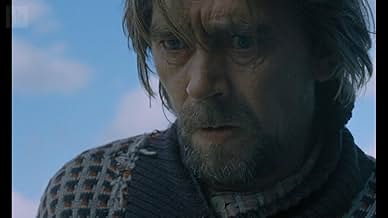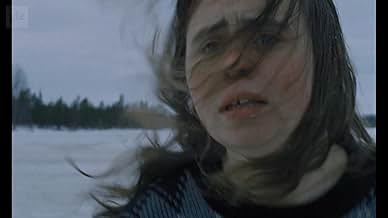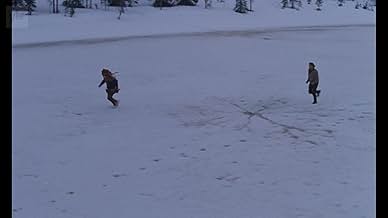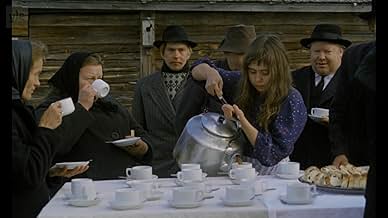PUNTUACIÓN EN IMDb
6,9/10
934
TU PUNTUACIÓN
Añade un argumento en tu idiomaA young woman has an intense affair with a womanizing reindeer herdsman.A young woman has an intense affair with a womanizing reindeer herdsman.A young woman has an intense affair with a womanizing reindeer herdsman.
- Premios
- 5 premios y 2 nominaciones en total
Argumento
¿Sabías que...?
- CuriosidadesThe shoot took over a year to complete in and near the deserted village of Kätkäjärvi, which was located roughly eight miles from the nearest real road in Kittilä. Although the village was accessible by off-road vehicle during warmer months and by horse-drawn sleigh in the winter, the crew mostly walked to the location. The crew had no real electricity so generators were used for power.
- ConexionesFeatured in Molle: Ohjaajamuotokuva akateemikko Rauni Mollbergista (1991)
Reseña destacada
Northern Finland, the late 1940s: Martta (Maritta Viitamäki) is an 18-year old promiscuous daughter of a poor family in a small village. She lives with her parents Juhani and Alli (Pauli Jauhojärvi and Milja Hiltunen) and grandfather Äijä (Aimo Saukko) and is often the target of the advances of a crass local man named Kurki-Pertti (Veikko Kotavuopio). Upon meeting a Sami reindeer herder Oula (Niiles-Jouni Aikio), Martta falls deeply in love with him and cannot see any other men the way she used to. However, her father thinks Oula is no good and threatens to kill him if he comes to see Martta at their home.
What strikes the viewer instantly when watching The Earth Is a Sinful Song is the tremendous naturalism of everything. The people, mostly amateur actors or just locals with no acting experience at all, are not made to look traditionally beautiful in any way; they would without a doubt be called very ugly by most audiences who are used to polished modern cinema. The plentiful nudity and sex are not sugared either, neither is the harsh treatment of animals that was once common in the society the film portrays: a calf is cut in pieces while still inside the cow's womb, reindeer are slaughtered by stabbing them in the heart, a dog is kicked, a hare is clubbed. Even one of the writers admitted that the filmmakers may well have gone too far in their pursuit of extreme realism, but the result is a powerful experience all the same.
The way of life on the vast plains and hills of Lapland comes across as thoroughly soaked in a unique combination of nature, love, sex, death, religion and alcohol. If Martta's romance with Oula represents love of classical infatuation type, more pleasure-driven sex certainly isn't out of the question in the village either as evidenced by Martta's escapades with Kurki-Pertti and her family's adopted son Hannes (Jouko Hiltunen), let alone the villagers' wild orgies during their drunken gatherings. The scene with a traveling preacher (Osmo Hettula) truly demonstrates the meaning of frenetic religion in the poor people's lives: the slimy preacher's misanthropic rant about the worthlessness of humanity driving the listeners into a trembling state of delirium and a crazed session of unrestrained sex marks truly the most memorable scene in the whole film. How empty must a person's life be when this kind of "message of love" is the only outside entertainment the village ever gets?
The film has been criticized for ignoring the poetic, beautiful side of Timo K. Mukka's original novel, but I think there's plenty of strange beauty to be found in the film. The gorgeous scenery of Lapland during the changing seasons is portrayed without dialog through visual means; just seeing the coloured leaves in the autumn, the reindeer herd running on the snow-covered plains, a boat floating at a lake at sunset or the green forests of the summer should be enough to provide contrast for the raw hardships in the people's lives. In the last act the pacing slows down significantly, focusing more on the inner feelings of the characters before and after the dramatic climax on a frozen lake, so I don't think the accusations of only wallowing in filthy despair are justified at all.
Last but not least, the actors are extremely convincing in their roles; what they lose in acting experience, they win gloriously in rough charisma. Especially Aimo Saukko definitely deserved his Jussi Award for his performance as the old man Äijä, and Maritta Viitamäki as the plump Martta carries a sense of raw beauty that only the vain are not willing to see. I have watched the film many times and enjoyed it every time; along with Mikko Niskanen's masterful miniseries Kahdeksan surmanluotia (Eight Deadly Shots, 1972), The Earth Is a Sinful Song is an important part of Finnish history on the silver screen. The meaning of nature, family, love, death and society to our recent ancestors is among the themes in these films and they show powerfully where we modern tech-savvy Finns are coming from, even if the lives of Martta and her family now feel distant and irrelevant to some. In my book, The Sinful Song is one of the best Finnish films ever made and essential viewing for anyone willing to understand this nation's psyche through cinema.
What strikes the viewer instantly when watching The Earth Is a Sinful Song is the tremendous naturalism of everything. The people, mostly amateur actors or just locals with no acting experience at all, are not made to look traditionally beautiful in any way; they would without a doubt be called very ugly by most audiences who are used to polished modern cinema. The plentiful nudity and sex are not sugared either, neither is the harsh treatment of animals that was once common in the society the film portrays: a calf is cut in pieces while still inside the cow's womb, reindeer are slaughtered by stabbing them in the heart, a dog is kicked, a hare is clubbed. Even one of the writers admitted that the filmmakers may well have gone too far in their pursuit of extreme realism, but the result is a powerful experience all the same.
The way of life on the vast plains and hills of Lapland comes across as thoroughly soaked in a unique combination of nature, love, sex, death, religion and alcohol. If Martta's romance with Oula represents love of classical infatuation type, more pleasure-driven sex certainly isn't out of the question in the village either as evidenced by Martta's escapades with Kurki-Pertti and her family's adopted son Hannes (Jouko Hiltunen), let alone the villagers' wild orgies during their drunken gatherings. The scene with a traveling preacher (Osmo Hettula) truly demonstrates the meaning of frenetic religion in the poor people's lives: the slimy preacher's misanthropic rant about the worthlessness of humanity driving the listeners into a trembling state of delirium and a crazed session of unrestrained sex marks truly the most memorable scene in the whole film. How empty must a person's life be when this kind of "message of love" is the only outside entertainment the village ever gets?
The film has been criticized for ignoring the poetic, beautiful side of Timo K. Mukka's original novel, but I think there's plenty of strange beauty to be found in the film. The gorgeous scenery of Lapland during the changing seasons is portrayed without dialog through visual means; just seeing the coloured leaves in the autumn, the reindeer herd running on the snow-covered plains, a boat floating at a lake at sunset or the green forests of the summer should be enough to provide contrast for the raw hardships in the people's lives. In the last act the pacing slows down significantly, focusing more on the inner feelings of the characters before and after the dramatic climax on a frozen lake, so I don't think the accusations of only wallowing in filthy despair are justified at all.
Last but not least, the actors are extremely convincing in their roles; what they lose in acting experience, they win gloriously in rough charisma. Especially Aimo Saukko definitely deserved his Jussi Award for his performance as the old man Äijä, and Maritta Viitamäki as the plump Martta carries a sense of raw beauty that only the vain are not willing to see. I have watched the film many times and enjoyed it every time; along with Mikko Niskanen's masterful miniseries Kahdeksan surmanluotia (Eight Deadly Shots, 1972), The Earth Is a Sinful Song is an important part of Finnish history on the silver screen. The meaning of nature, family, love, death and society to our recent ancestors is among the themes in these films and they show powerfully where we modern tech-savvy Finns are coming from, even if the lives of Martta and her family now feel distant and irrelevant to some. In my book, The Sinful Song is one of the best Finnish films ever made and essential viewing for anyone willing to understand this nation's psyche through cinema.
- random_avenger
- 23 ago 2010
- Enlace permanente
Selecciones populares
Inicia sesión para calificar y añadir a tu lista para recibir recomendaciones personalizadas
- How long is The Earth Is a Sinful Song?Con tecnología de Alexa
Detalles
Taquilla
- Presupuesto
- 860.000 FIM (estimación)
- Duración1 hora 48 minutos
- Mezcla de sonido
- Relación de aspecto
- 1.66 : 1
Contribuir a esta página
Sugerir un cambio o añadir el contenido que falta

Principal laguna de datos
By what name was Cancion para la tierra triste (1973) officially released in Canada in English?
Responde
















